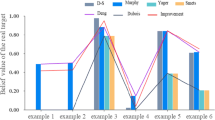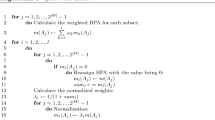Abstract
There is doubt about Dempster’s rule of combination because of counter-intuitive results when dealing with conflict information in intelligent reasoning. Therefore, many modified combination rules have been presented in the literature on multi-source information fusion and reasoning with uncertainty. However, the issue of identifying conflict among evidence has been ignored. A new parameter measuring conflict evidence called the conflict distance parameter is defined to determine whether there are conflicts in evidence based on the analysis of existing conflict parameters. At the same time, a decisive rule, which a reasonable conflict measure function should satisfy, is put forward. Finally, an analysis of two typical counter-intuitive situations is given, showing that the new parameter can not only satisfy the decisive rule, but can also attain the same effect as a two-dimensional measure when deciding whether to use the Dempster’s rule of combination, and can exceed its effect when deciding whether to use Dezert-Smarandache theory.
Similar content being viewed by others
References
He Y, Wang G H, Guan X. Information Fusion Theory with Applications. Beijing: Publishing House of Electronics Industry, 2010
Shafer G. A Mathematical Theory of Evidence. Princeton: Princeton University, 1976
Zadeh A L. Review of books: A mathematical theory of evidence. AI Mag, 1984, 5: 81–83
Yager R R. Using approximate reasoning to represent default knowledge. Artif Intell, 1987, 31: 99–112
Yager R R. General approach to the fusion of imprecise information. Int J Intell Syst, 1997, 12: 1–29
Smets P. The combination of evidence in the transferable belief model. IEEE Trans Patten Anal Mach Intell, 1990, 12: 447–458
Smets P. Analyzing the combination of conflicting belief functions. Technical Report, IRIDIA, Universite Libra de Bruxelles, 2004
Dubois D, Prade H. Consonant approximation of Dempster-Shafer theory. Int J Approx Reason, 1990, 4: 419–449
Lefvre E, Colot O, Vannoorenberghe P, et al. A genenic framework for resolving the conflict in the combination belief structures. In: Proceedings of the Third International Conference on Information Fusion. 2000, (l): 11–18
Murphy C. Combining belief functions when evidence conflicts. Decision Support Syst, 2000, 29: 1–9
Deng Y, Shi W K, Zhu Z F. Efficient combination approach of conflict evidence. J Infrared Millim Waves. 2004, 23: 27–32
Guan X, Yi X, Sun X M, et al. Efficient fusion approach for conflicting evidence. J Tsinghua Univ (Sci & Tech), 2009, 49: 138–141
Liu W R. Analyzing the degree of conflict among belief functions. Artif Intell, 2006, 5: 909–924
Wang D, Jiang W, Luo R, et al. Method of measure the conflict between evidences based on the OWA operator. In: The 1st National Conference on Information Fusion, Yantai, China, 2009. 21–27
Smarandache F. A Unifying Field in Logics: Neutrosophic Logic, Neutrosophy, Neutrosophic Set, Probability, and Statistics. Rehoboth: American Research Press, 2000. http://www.gallup.unm.edu/~smarandache/neutrosophy.htm
Dezert J, Smarandache F. Advances and Applications of DSmT for Information Fusion. Rehoboth: American Research Press, 2004
Jousselme A, Grenier D, Bosse E. A new distance between two bodies of evidence. Inf Fusion, 2001, 2: 91–101
Martin A, Jousselme A, Osswald C. Conflict measure for the discounting operation on belief functions. In: The 11th International Conference on Information Fusion. Cologne, 2008. 1–8
Hu L F, He Y, Guan X, et al. Measuring conflict functions in the generalized power space. Chinese J Aeronaut, 2010 (Revision)
Yang F B, Wang X X. Combination Method of Conflictive Evidences in D-S Evidence Theory. Beijing: National Defense Industry Press, 2010
Author information
Authors and Affiliations
Corresponding author
Rights and permissions
About this article
Cite this article
He, Y., Hu, L., Guan, X. et al. New method for measuring the degree of conflict among general basic probability assignments. Sci. China Inf. Sci. 55, 312–321 (2012). https://doi.org/10.1007/s11432-011-4346-0
Received:
Accepted:
Published:
Issue Date:
DOI: https://doi.org/10.1007/s11432-011-4346-0




